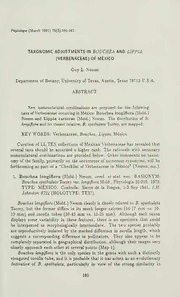
TAXONOMIC ADJUSTMENTS IN BOUCHEA AND LIPPIA VERBENACEAE OF MEXICO PDF
Preview TAXONOMIC ADJUSTMENTS IN BOUCHEA AND LIPPIA VERBENACEAE OF MEXICO
Phyiologia (March 1991) 70(3):]85-187. TAXONOMIC ADJUSTMENTS IN BOUCHEA AND LIPPIA (VERBENACEAE)OF MEXICO Guy L. Nesom Department of Botany, University of Texas, Austin. Texas 78713 U.S.A. ABSTRACT New nomenclatujal combinations are proposed for the following taxaofVerbenaceae occurringinMexico: Bouchea longiflora (Mold.) Nesom and Lippia carterae (Mold.) Nesom. The distribution of B. longiflora and its closest relative, B. spathulaia Torrey, are mapped. KEY WORDS: Verbenaceae, Bouchea, Lippia. Mexico Curation of LL.TEX collections ofMexican \'erbenaceae has revealed that several taxa should be accorded a higher rank. The rationale with necessary nomenclatural combinations are provided below. Other comments on taxon- omy ofthe family, primarily on the occurrence ofnumerous synonyms, will be forthcoming as part of a "Checklist ofVerbenaceae in Mexico" (Nesom, ms.). 1. Bouchea longiflora (Mold.) Nesom. coml. et siai. not. BASIONYM: BoucheaspathulaiaTorrey var. longifloraMold., Phytologia 23:210. 1972. TYPE: MEXICO. Coahuila: Sierra de la Fragua, 1-3 Sep 1941, I.M. Johnston 812\ (HOLOTYPE: TEX!). Bouchea longiflora (Mold.) Nesom clearlyis closely related to B. spathulata mm Torrey, but the former differs in its much longer calyces (14-17 vs. 10- 12 mm) and corolla tubes (30-45 mm vs. 15-25 mm). Although each taxon displays some variability in these features, there is no specimen that could be interpreted as morphologically intermediate. The two species probably are reproductively isolated by the marked difference in corolla length, which suggests a corresponding difference in pollinators. They also appear to be completel}" separated in geographical distribution, although their ranges very closely approach each other at several points (Map 1). Bouchea longiflora is the only species in the genus with such a distinctly elongated corolla tube, and it is probable that it has arisen as an evolutionary derivative of B. spathulaia, particularly in view of the strong similarity in 185 18C P H Y T L G } A volume T0(3):185-187 March 1991 TEX Map 1. Distribution of Bouchta longiflora and B. spaihulaia. All data points arefrom LL, TF.X specimens, except for threelocalities in Texasfor B. spaihu- laia added from Moldenke (1940). .Abbreviations are for Texas (TEX) and the Mexican states Coahuila (CO.A.), Chihuahua (CHI), Durango (DUR), and Nuevo Leon (KUE). Nesom: Taxonomic adjuslments in Bouchea and Lippia 187 other morphological features between these two species. Both species flower from about April to November and both occur in essentially the same type of habitats ofmatorral orchaparral at thesameelevations (ca. 1200-1900 meters), although B. spathulata, with more collections available, has been recorded at somewhat higher and lower sites. 2. Lippia carterae (Mold.) Nesom, comb. nov. BASIONYM: Lippia alha (MiU.) N.E. Britt. var. carterae Mold., Phytologia 7:430. 1961. TYPE: MEXICO. Baja California Sur: Sierra de la Giganta, dry rocky bed of Arroyo Santo Domingo, Rancho El Horno (northeast of San Xavier), 17 Mar 1960, A. Carter & R. Ferris 386J, (HOLOTYPE: UC:"lsotype: TEX!). Lippia alba (Mill.) N.E. Britt. is a widespread and somewhat variable species, but the plants regarded here as L. carterae (Mold.) Nesom are clearly outside the bounds of variation of any population of L. alba. Most promi- nently, while the pubescence of L. alha is strigose, composed ofstiff, relatively thick based hairs, L. carterat produces a dense, close tomentum offine, white, crinkled hairs on the stems, leaves, and floral bracts. The leaf surfaces have an understory offine tomentum. with much longer, straight, stifTer, "fl/6a-like" hairs intermixed on the upper surface and along the veins ofthe lower surface. Further, the corollas of L. carterae are distinctly yellow, as noted by Mold- enke in the original description, in contrast to the v.-hite to pink or purplish corollas of L. alha. Lippia carteraeis endemic to Baja California Sur although ^^'iggins (1980) treated it as L. alba. The latter is a common species from southern Texas through Mexico and into Central America; it is known from the southwestern Mexican states of Sinaloa, Nayarit, Jalisco, and Colima, but over its whole range it apparently grows in much more humid habitats than does L. carterae. There are no records of the occurrence of L. alha in Baja California. ACKNOWLEDGMENTS 1 thank Dr. B.L. Turner and Dr. B.B. Simpson for their review and com- ments on the manuscript. L1TER.4TURE CITED Moldenke, H.N. 1940. A monograph ofthegenus Bouchta. II. Feddes Repert. Spec. Nov. Regni Veg. 49:91-139. \\'iggins, I.L. 1980. Flora ofBaja California. Stanford Univ. Press, Stanford, California.
